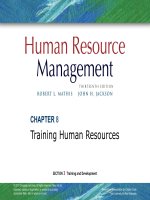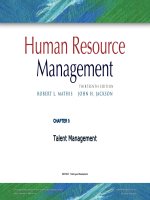Human resrouce management 12th mathis jacson chapter 005
Bạn đang xem bản rút gọn của tài liệu. Xem và tải ngay bản đầy đủ của tài liệu tại đây (1.55 MB, 32 trang )
CHAPTER 5
Managing Equal Employment
and Diversity
Section 2 Staffing the Organization
© 2008 Thomson/South-Western All rights reserved.
PowerPoint Presentation by Charlie Cook
The University of West Alabama
Chapter
Chapter Objectives
Objectives
After you have read this chapter, you should be able to:
■ Discuss racial/ethnic discrimination concerns involved
with harassment and language issues.
■ Describe how women are affected by pay, job
assignment, and career issues in organizations.
■ Define the two types of sexual harassment and how
employers should respond to sexual harassment
complaints.
■ Identify two means that organizations are using to deal
with the aging of their workforces.
© 2008 Thomson/South-
5–2
Chapter
Chapter Objectives
Objectives (cont’d)
(cont’d)
After you have read this chapter, you should be able to:
■ Discuss how reasonable accommodation is made when
managing individuals with disabilities and differing
religious beliefs.
■ Evaluate several arguments supporting and opposing
affirmative action.
■ Explain diversity management and discuss why
diversity training is important.
© 2008 Thomson/South-
5–3
FIGURE 5-1
Equal Employment and Diversity Management
© 2008 Thomson/South-
5–4
Race, National Origin, and Citizenship Issues
Potential HR Issues
Racial/Ethnic
Discrimination
and Harassment
English-Only
Requirements and
Bilingual Employees
© 2008 Thomson/South-
Requirements for
Immigrants and
Foreign-Born
Workers
5–5
FIGURE 5-2
Recent Year Charge Statistics from EEOC
Note: Because individuals often file charges claiming multiple types of
discrimination, the total percentages may exceed 100%. Total charges = 75,428.
Source: U.S. Equal Employment Opportunity Commission, 2006, www.eeoc.gov/stats/charges.html.
© 2008 Thomson/South-
5–6
Sex/Gender Issues
• Pay Inequity
To guard against pay inequities, employers should:
Include
benefits and other items of remuneration to
calculate pay.
Inform
Base
all employees how pay practices work.
pay on the value of jobs and performance.
Benchmark
pay against local and national markets
so that pay structures are competitive.
Conduct
audits to detect gender-based inequities
and ensure that pay is fair internally.
© 2008 Thomson/South-
5–7
FIGURE 5-3
Female Annual Earnings as Percentage of Male Earnings
Source: U.S. Department of Labor, Bureau of Labor Statistics, 2006, www.bls.gov.
© 2008 Thomson/South-
5–8
FIGURE 5-4
Women as Percentage of Total Employees by Selected Industries
Source: U.S. Bureau of Labor Statistics, “Employed Persons by Detailed Industry and Sex,” 2006, www.bls.gov.
© 2008 Thomson/South-
5–9
Sex/Gender Issues
Women in the Workforce Issues
Nepotism
Job Assignments
and Nontraditional
Jobs
© 2008 Thomson/South-
Glass Ceilings,
Walls and
Elevators
5–10
Sex/Gender Issues (cont’d)
Establishing
mentoring
programs
Providing
career rotation
Breaking
the Glass
Increasing top
management and
boardroom
diversity
Allowing for
alternative work
arrangements
Establishing goals
for diversity
© 2008 Thomson/South-
5–11
Sex/Gender Issues (cont’d)
• Individuals with Differing Sexual Orientations
Federal courts and the EEOC have ruled that sex
discrimination under Title VII applies to a person’s
gender at birth.
Sexual orientation or sex-change issues that arise at
work include:
Reactions
Fair
of co-workers and managers
evaluation and no discrimination
Continuing
acceptance
© 2008 Thomson/South-
5–12
Sexual Harassment and
Workplace Relationships
• Consensual Relationships
and Romance at Work
Workplace romances are
risky because they can
cause conflict or result in
sexual harassment.
© 2008 Thomson/South-
5–13
Types of Sexual Harassment
Quid Pro Quo
Hostile Environment
Linking employment outcomes
to the harassed individual’s
granting of sexual favors.
Allowing intimidating or
offensive working conditions
to unreasonably affect an
individual’s performance or
psychological well-being.
© 2008 Thomson/South-
5–14
FIGURE 5-5
Potential Sexual Harassers
© 2008 Thomson/South-
5–15
Employer Responses to Sexual Harassment
Establishing a sexual
harassment policy
Communicating the
policy regularly
Affirmative
defense for
employer
Training employees to
avoid sexual
harassment
© 2008 Thomson/South-
Investigating and
taking actions when
complaints arise
5–16
FIGURE 5-6
Sexual
Harassment
Liability
Determination
Source: Virginia Collins, PhD, SPHR, and Robert L. Mathis, PhD, SPHR, Omaha, Nebraska.
© 2008 Thomson/South-
5–17
Age Issues and EEO
Age Discrimination and
Employment Issues
Discrimination
against
“overqualified”
older employees
Age discrimination in
workforce reductions
(ADEA and OWBPA)
© 2008 Thomson/South-
Attracting, retaining,
and managing older
workers
5–18
HR Managers’
Views of Older
Workers
Consequences
•
•
•
•
Health care usage
Heath care costs
More training/retraining
Employee stress
Older
Workers
Advantages
Disadvantages
•
•
•
•
•
• Are weak on new technology
• Cause expenses to rise
• Are less flexible
Will work different schedules
Serve as mentors
Have invaluable experience
Have a strong work ethic
Are more reliable
© 2008 Thomson/South-
5–19
Individuals with Disabilities in the Workforce
Recruiting and
Selecting Individuals
with Disabilities
Employees Who
Develop Disabilities
Managing
Individuals
with
Disabilities
Individuals with
Mental Disabilities
© 2008 Thomson/South-
Individuals with LifeThreatening Illnesses
5–20
FIGURE 5-7
Common Means of Reasonable Accommodation
© 2008 Thomson/South-
5–21
FIGURE 5-8
Religion and Spirituality in Workplaces
© 2008 Thomson/South-
5–22
Affirmative Action
• Affirmative Action
Employers are urged to hire groups of people based
on their race, age, gender, or national origin to make
up for historical discrimination.
• Affirmative Action and the U.S. Courts
Courts have upheld the legality of affirmative action,
but recently have limited it somewhat.
University of Michigan cases
• Reverse Discrimination
Occurs when a person is denied an opportunity
because of preferences given to protected-class
individuals who may be less qualified.
© 2008 Thomson/South-
5–23
Debate on Affirmative Action
Affirmative Action
Is Still Needed
• To overcome and eliminate the
effects of past injustices.
• To create equality for all persons,
even if temporary injustice to
some individuals may result.
Affirmative Action Is
No Longer Needed
• Penalizes individuals even though
they have not been guilty of
discrimination.
• Creates preferences that result in
reverse discrimination.
• Employment of protected-class
members will benefit society.
• Results in greater polarization
and separatism.
• Properly used, does not
discriminate against males or
whites.
• Stigmatizes those it is designed to
help.
• Goals indicate progress needed,
not quotas.
© 2008 Thomson/South-
• Forces employers to “play by the
numbers” as goals become
quotas.
5–24
Affirmative Action
• Affirmative Action Plan (AAP)
A requirement for federal government contractors with more
than 50 employees and over $50,000 in government contracts
annually to formally document the inclusion of women and racial
minorities in the workforce.
Covered employers must submit plans describing their attempts
to narrow the gaps between the composition of their workforces
and the composition of labor markets where they obtain
employees.
Focuses on hiring, training, and promoting protected-class
members who are under-represented in an organization in
relation to their availability in the labor markets from which
recruiting occurs.
© 2008 Thomson/South-
5–25









